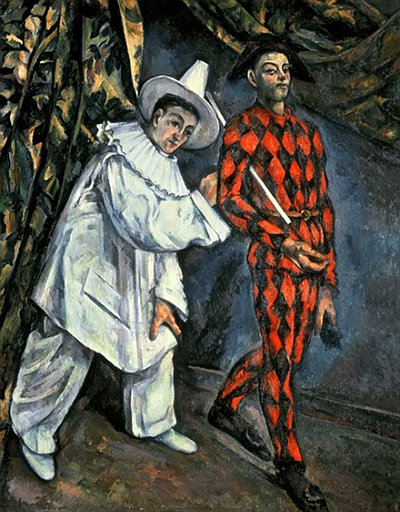Harlequin (a comic servant), and the sad, lovelorn Pierrot pining for Columbine, are both well-known characters from Italian Comeddia dell'Arte, a masked form of theatre originating in 16th-century Italy.
They are often represented at carnivals, and as a boy in his home-town of Aix-en-Provence, the young Cézanne would have seen annual celebrations around the time of Lent. Interested in art from an early age, he produced many sketches of the Mardi Gras, and three of Harlequin.
This later-period and final rendition, called Pierrot and Harlequin, was produced in the artist's Paris studio on the Rue du Val-de-Grace in 1888, and is owned by Russia's Pushkin Museum.
The painter's son Paul takes on the role of the traditionally-mischievous Harlequin in his bright and stylish outfit, while Paul's friend Louis Guillaume models the looser, quieter costume of Pierrot.
There is tension here between the arrogance of Harlequin and the melancholic air of Pierrot, who appears to follow passively. However, this could be read as suppressed emotion, or as a suggestion of what he really thinks of his more confident companion. Certainly, the two appear as separate beings, not progressing as equals.
Technically, the artist challenged the laws of perspective on this canvas, with the steep floor highlighting distortions, making it necessary to lengthen the feet of the front figure. The drapes in the background could place the tableau in a theatre, and show the artist's care and draughtmanship in portraying material and clothing.
Paul Cézanne's technique was to utilise planes of colour and short brush strokes that built up a complex, intensely focused whole.
His school friend, the future novelist Emile Zola, encouraged him to develop his distinctive style, and to give up the banking course that his father insisted upon. Eventually his parents gave in and sent him to study in Paris, with essential financial support.
Cézanne was never fully satisfied with his own work, especially regarding the figures, which were hampered by his way of applying brush strokes.
Although recognised amongst the older impressionists, and admired by younger painters like Van Gogh and Gauguin, who recognised that new ideas were needed to refresh the art of the day, it wasn't until 1895 that a Parisian art dealer began to promote his work. This, and a major exhibition of 1904, gave him the status and recognition that he deserved, before his death in Aix in 1906.
Born in 1839, the post-impressionist Paul Cézanne is credited with having smoothed the transition and direction of art between the 19th and 20th centuries, leading it from Impressionism towards Cubism, with both Picasso and Matisse said to have called him the "father of us all".
The artist was at first associated with the impressionists, and influenced by painters such as Pissarro, Manet and Delacroix, but he did not join them as a group.
He did exhibit with them a couple of times, but his style wasn't well-received critically.




